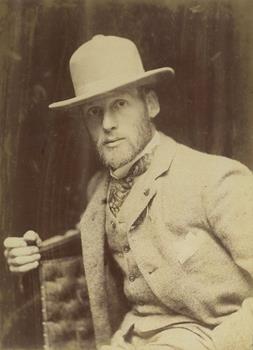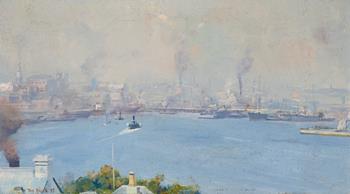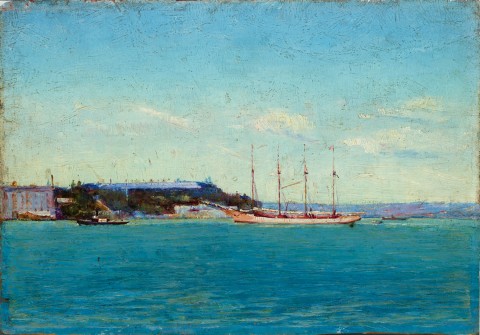KIRRIBILLI POINT, SYDNEY, c.1895
TOM ROBERTS
oil on wood panel
18.0 x 25.5 cm
Mr H. L Johnstone
Leonard Joel, Melbourne, 7 March 1969, lot 26 (as ‘Sydney Harbour, c.1880’)
Private collection, Adelaide
Thence by descent
Private collection, Adelaide
Exhibition of Past Australian Painters Lent From Private South Australian Collections, Adelaide Festival of Arts, John Martin & Co. Limited, Adelaide, 8 – 29 March 1974, cat. 98 (as ‘Summer’)
Spate, V., Tom Roberts, Lansdowne Press, Melbourne, 1978, cat. 86
Topliss, H., Tom Roberts: A Catalogue Raisonné, vol. I, Oxford University Press, Melbourne, 1985, cat. 284, vol. II, pl. 128 (as ‘Untitled, Kirribilli Point’, c.1890 – 98)
Tom_Roberts,_Australian_artist,_ca._1895_photographer_Talma_Studio_(4668257926).jpg

Hailed as the father of Australian landscape painting, Tom Roberts holds a significant place in the history of Australian art. With Fred McCubbin and Louis Abrahams, he established the first painting camp at Box Hill in the summer of 1885, cementing the local practice of plein air painting with naturalistic images which celebrated the ‘wild bush, tall young saplings with the sun glistening on their leaves’.1 Four years later, Roberts was the instigator of the famous 9x5 Impression Exhibition held at Buxton’s Rooms in Melbourne, where 183 small paintings – many on cigar box lids – declared that quick, painterly impressions emphasising fleeting atmospheric effects were the artistic order of the day.
Roberts is perhaps best known, however, for his large and consciously nationalistic pictures which have become iconic depictions of life in Australia including Shearing the Rams, 1888-90 (National Gallery of Victoria) and A Break Away!, 1891 (Art Gallery of South Australia). Painted during the late nineteenth century, in the years leading up to the Federation of Australia, these pictures remain on permanent display in the public galleries that house them, markers of national identity centred on rural life and activity, which still have relevance despite Australia’s urbanisation and the fact that most of the population resides in cities along the coastal periphery.
Although Roberts and his fellow members of the so-called Heidelberg School are strongly associated with the rural Australian landscape, they lived predominantly urban lives and were at home in close proximity to the city. Bush scenes were painted during camps and on excursions made possible by the extension of the railway network around Melbourne. Later, Roberts travelled widely, seeking varied subjects for his work, but he also consistently maintained city-based studios. In Melbourne for example, he was at 95 Collins Street in 1885 – where he probably began work on the view of Melbourne’s bustling centre, Allegro con brio, Bourke Street west, c.1885-86, reworked 1890 (National Gallery of Australia and the National Library of Australia) – then the St James Building, 59 William Street (1887) and from 1888, a residential studio on the top floor of Collins Street’s new Grosvenor Chambers. A member of the Buonarotti Club, as well as a founding member of both the Australian Artists’ Association and the Victorian Artists’ Society, Roberts was actively involved in Melbourne’s artistic community during these years. He also understood the importance of cultivating the audience for his work, and the critical need for enthusiastic patrons, opening his studio for previews and socialising with the right people. To this end, he was successful, as the range of sitters who feature in his extensive portrait oeuvre attests.
Visiting Sydney for several weeks in March-April 1888, Roberts met the young Charles Conder and working side by side, the two artists famously painted views of Coogee Bay from the same vantage point.2 Roberts’ Holiday Sketch at Coogee, 1888 (Art Gallery of New South Wales) reflects his delight in the beauty of the scene and the intensity of Sydney’s light and colour. The vibrant blue of the ocean is a central focus. Other seascapes from the time were ‘executed with unprecedented boldness … Roberts was not so much depicting the objective being of the landscape, as expressing his subjective reaction to it. He translated his external delight into sensuously handled paint.’3
346.1985##S.jpg

The chromatic brilliance of harbourside Sydney is also a primary focus of this view. A study of sea and sky, the picture is divided into two broad horizontal bands, the pale blue of the sky, broken up with occasional white clouds, reflected in the vivid blue of the calm water below. Helen Topliss has identified the area seen across the open water as Kirribilli Point, and the distinctive multi-storey building on the left hand side appears to be the Pastoral Finance Association Wool Store, which was constructed in 1892 adjacent to the grounds of Admiralty House, the long roof of which can be seen to the right.4 The seven storey PFA warehouse was reportedly ‘one of the most conspicuous [buildings] on the harbour front’5 and when it burned down in December 1921 along with the 30,000 bales of wool it housed, provided ‘a magnificent spectacle … for the thousands of ferry passengers … who watched the devastating progress of the fire’.6 The industry that characterised much of harbourside Sydney during the late nineteenth century is highlighted by the nearby tug boat, a short white wake describing its slow and steady path. The most prominent man-made element of the scene is the elegant four-masted schooner to the right, which directs the view into the distance beyond Kirribilli Point towards Bradleys Head, with Fort Denison visible in between. Topliss highlights the variety in Roberts’ painting technique, pointing out that the lines on the side of the vessel are incised with the end of a paint brush.7 The textured sky too, exemplifies his lively brushwork.
Roberts had been resident in Sydney since 1891, when he arrived from Melbourne by ship with Arthur Streeton, and took up residence at Curlew Camp on Little Sirius Cove. Living at the beachside campsite on and off until his marriage five years later, Roberts had constant access to the water and Kirribilli Point, thought to have been painted during the mid-1890s, reflects his intimate knowledge of the myriad moods and colours of the harbour.
1. Nancy Elmhurst Goode quoted in Whitelaw, B., ‘’Plein Air’ Painting: The Early Artists’ Camps Around Melbourne’ in Clark, J. and Whitelaw, B., Golden Summers: Heidelberg and Beyond, National Gallery of Victoria, Melbourne, 1985, p. 55
2. Tom Roberts, Holiday Sketch at Coogee, 1888 (Art Gallery of New South Wales) and Charles Conder, Coogee Bay, 1888 (National Gallery of Victoria). See Eagle, M., ‘Friendly Rivalry: Paintings of Waterside Sydney, 1888 and 1890’ in Lane, T., Australian Impressionism, National Gallery of Victoria, Melbourne, 2007, pp. 103 – 108
3. Spate, V., Tom Roberts, Lansdowne Editions, East Melbourne, 1978, p. 52
4. Topliss, H., Tom Roberts 1856-1931: A Catalogue Raisonné, vol. 1, Oxford University Press, Melbourne, 1985, cat. 284, p. 152. Topliss notes ‘the building on the left is Dalgetty’s [sic.] woolshed, which burned down in 1926’, however research suggests that the wool store was owned by the Pastoral Finance Association and burned down in 1921. See ‘The Leading Wool Selling Houses of Sydney’, The Sydney Wool and Stock Journal, 9 May 1902, p. 7; ‘The Great Sydney Fire: Destruction of the P.F.A. Stores’, Sydney Mail, 21 December 1921, p. 5 and ‘Kirribilli’s Great Fire’, Sydney Morning Herald, 17 May 1954, p. 7.
5. Sydney Mail, ibid.
6. Ibid.
7. Topliss, vol. 1, op. cit., p. 152
KIRSTY GRANT
